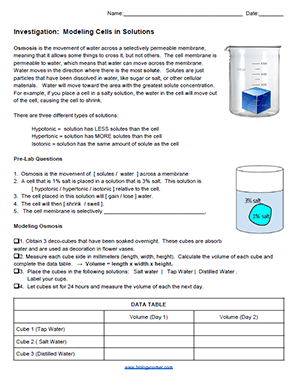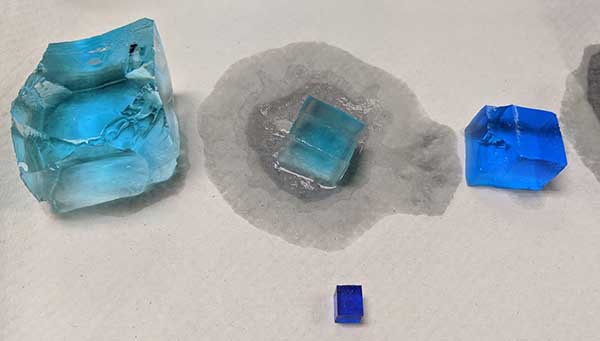
There are many labs that students can perform that demonstrate osmosis. I have had students soak potatoes or carrots in salt and DI water and then record the change in mass. (Investigation: The Effect of Salt on a Potato).
AP Biology students use dialysis tubes and sucrose solutions to observe how each tube changes in mass in response to the molarity of the solution they are soaked in. This advanced class will even determine the molarity of an unknown based on what they have learned. (AP Biology: Osmosis and Water Potential)
This basic lab uses Deco-cubes to show how they change in size when soaked in salt water, distilled water, and tap water. The cubes are square in shape (mostly) which has an advantage over other labs where students measure mass changes. You don’t need balances or scales! Students can calculate volume by using a ruler and measuring each side of the cube.
The image shows the cubes after soaking. The large cube is the one soaked in distilled water. The middle cube was soaked in salt and the last cube was the one in tap water. The bottom cube is the original size of the cube before soaking. Note: You will need to soak these for a couple of hours before the lab.

I do have a student handout for the lab which includes background information on osmosis, solute concentrations, and the different types of solutions (isotonic, hypertonic, hypotonic), but you could easily do this without a handout by just writing instructions on the board and walking them through the procedure and having a discussion the next day.
Grade Level: 7-12
Time Required: 10-15 minutes for initial set-up, 15-20 minutes for analysis (day 2)
HS-LS1-3 Plan and conduct an investigation to provide evidence that feedback mechanisms maintain homeostasis.
HS-LS1-2 Develop and use a model to illustrate the hierarchical organization of interacting systems that provide specific functions within multicellular organisms

